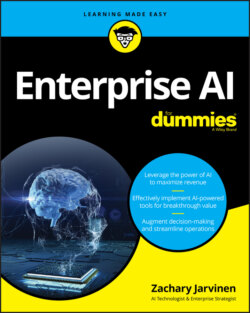Читать книгу Enterprise AI For Dummies - Zachary Jarvinen - Страница 36
Learning
ОглавлениеFor the purposes of ML, historical data is called training data. In the case of text mining, the system uses OCR and NLP to process text. For images, the system uses computer vision techniques for detection, recognition, and identification to process the image.
The algorithm processes the data to detect key patterns and trends and correlate them to labels. For example, if you’re doing text mining, the algorithm might notice certain words being associated with elephants, such as large, gray, tusk, and trunk, and associate those with the label “elephant.” Later, in the prediction phase, when the algorithm sees a significant number of these terms, it calculates the probability that the passage is talking about an elephant.
In the learning phase, the system applies statistical techniques or algorithms to the historical data to generate a machine-learning model. You can think of the model as a set of rules or instructions (similar to steps in a recipe) that one must follow to make a business decision.
For example, to approve a loan application, a loan officer considers income, age, net worth, and many other factors. Each attribute of the application is a rule or factor that the officer must evaluate to approve or reject the loan. Machine-learning techniques follow a similar process, comparing various attributes, historical decisions, and the outcome of similar applicants to estimate the credit worthiness of the new applicant. Table 1-3 shows how machine learning is like a recipe.
